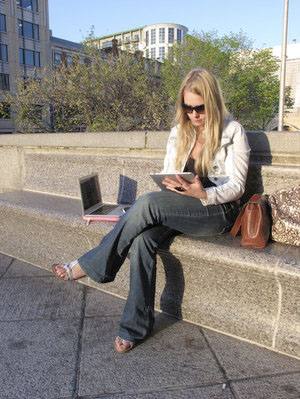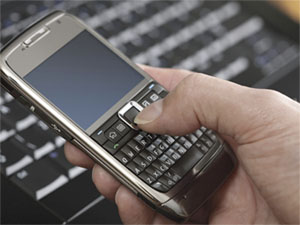May 10, 2010
By JOSHUA BROCKMAN
Leslie Bradshaw knows exactly what she wants when she heads to Starbucks.
On a recent afternoon at a Washington, D.C., branch of the popular cafe, she ordered an iced skim chai and then got right down to business by opening up her MacBook Air.
For Bradshaw, 27, it’s not the cold beverages that are the main draw. She’s here for the wireless hotspot that she uses to get online.
“I have no television, I have no land line, and I actually have no Wi-Fi even though I run a high-tech digital agency,” says Bradshaw, who is president of JESS3, a Web design and branding company. “It really comes down to my BlackBerry, which is all kind of what I need, and my Kindle.”

Leslie Bradshaw displays her iPad and MacBook Air — some of the wireless devices she carries with her. Bradshaw — who doesn’t have a land line, high-speed Internet or subscription TV at home — describes herself as a “digital gypsy.” Joshua Brockman/NPR.
Cable, phone and satellite companies run lots of ads in the competition to install their wires and dishes to deliver high-speed Internet and high-definition television. It’s a $118 billion industry, according to SNL Kagan, an agency that tracks the communications business.
A ‘Digital Gypsy’
But even while more and more cable gets rolled out, there are some people, like Bradshaw, who are well-connected — just not wired.
“It’s kind of liberating,” Bradshaw says. “I joke that I’m somewhat of a digital gypsy in the sense that I can pack everything up in my purse and kind of really work from anywhere.”
Bradshaw is a road warrior who doesn’t like to wait around for the cable guy.
“I’m really on the road quite a bit,” she says. “And then related to that is just being really, really busy and not being around to sit and wait for six hours for somebody to come in and install something.”
Searching For Savings
There are a number of 20-something consumers, like Andrea Pendleton of Atlanta, who don’t see an upside to paying for wires. In her blog, Single & Saving, Pendleton, 26, wrote about her recent decision to live without cable. It will help her save almost $500 a year, she says.
“I definitely have realized that I can survive without it, and there are a lot of options to still be entertained without having a cable subscription,” Pendleton says.
Pendleton bought an HDTV antenna for her digital TV that enables her to pick up 42 channels for free. And when it comes to Internet access, she’s online at work all day and has access to free Wi-Fi at plenty of venues near her home.
Still, the cable industry says it hasn’t seen a lot of digital gypsies cancel their subscriptions.
“The concept of people leaving in droves has not borne itself out at least of yet,” says Alexander Dudley, a spokesman for Time Warner Cable.

Some 20-something consumers say they prefer to use Wi-Fi at cafes or other venues, rather than pay for high-speed Internet service at home. iStockphoto.com.
He says subscribers continue to add high-speed Internet service. But when it comes to paying for TV, about 800,000 U.S. households cut their TV subscriptions in 2008 and 2009, according to The Convergence Consulting Group. And while experts think that’s a relatively small number now, they expect the cord cutting trend to grow.
A Precedent For Cord Cutting
There’s a precedent for that: The latest government data from the Centers for Disease Control and Prevention show that almost one-quarter of American homes have only a mobile phone — no traditional land line. That number has more than doubled from 2006.
Forrester Research analyst Charles Golvin says that in the past, people would cut their land line for mobility and cost savings. “But today, the driver is much more what you might even call cord never-getters as opposed to cord cutters,” he says.
Golvin is referring to teenagers who start out with a cell phone and keep the number forever. Still, when it comes to living the cable-free life, he says we’re not there yet.
“If living the untethered lifestyle is really just about being able to communicate and browse the Web and get your e-mail and do the mass of things that people do online — with the exception of watching gobs of video — absolutely, you can do that today,” Golvin says.
New high-speed wireless networks are under construction that will deliver more video. These so-called 4G networks include Long Term Evolution (LTE), the standard that Verizon and AT&T plan to use, as well as WiMax, which Clearwire is developing for Sprint and other companies.
But even when they’re in place, we’ll still need power cords and chargers — some of the smaller wires in our lives.
© NPR
